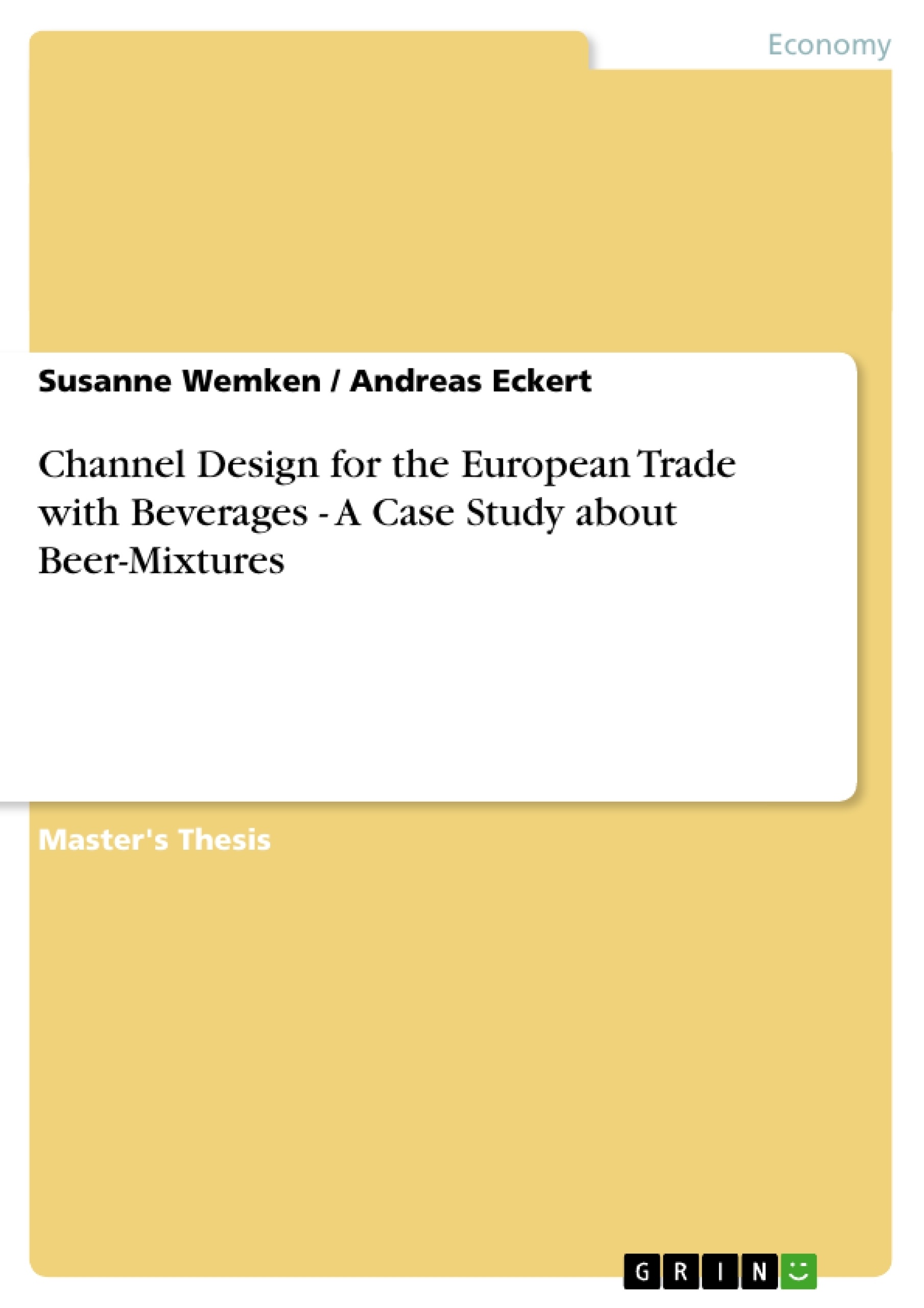The thesis on hand is dealing with the rather specific issue of the export business of the German brewery Herforder, which considers to market its product branch “beer-mixtures” in Sweden. Within the thesis, there are presented three possible distribution channel designs, consisting for example of the manufacturer, can-supplier, contract-bottlers, importers and transportation companies.
Each channel opportunity is described and the reasons that influence the decision for or against one particular channel are explained. Furthermore, the theoretical background is given, which exemplifies why companies start to consider internationalisation and how they can cope with the related challenges. The exporting issue is observed from a theoretical point of view and supplemented with much information concerning relationships within distribution channels. Two aspects which are very important for international trade are also investigated theoretically. Firstly there is the production aspects of beverages respectively beer and beermixtures including requirements for packaging and the production process itself. And secondly there is the transportation aspect including some information about IT systems. With respect to the target market Herforder aims at, there is one special chapter about the Swedish market, its constraints and its peculiarities in connection with alcohol import. Moreover, the high-sophisticated return system for beverage repositories in Sweden is discussed in this context.
In the empiricism potential companies that are suitable to make up the export distribution channel Herforder desires are presented in detail. The empirical part finalises with the setting up of three distribution channels which are determined through the location of bottling facilities.
Inhaltsverzeichnis (Table of Contents)
- Acknowledgements
- Table of Contents
- List of Figures
- List of Tables
- List of Abbreviations
- 1. Introduction
- 1.1. Background - Change Is The Only Constant
- 1.2. Problem Discussion - At the Crossroads
- 1.3. Purpose The Thesis' Intention
- 1.4. Limitations - Flagging the Claim
- 1.5. Theoretical and Practical Relevance
- 1.5.1. Theoretical Relevance
- 1.5.2. Practical Relevance
- 1.6. Definitions
- 2. Methodology
- 2.1. Preunderstanding
- 2.1.1. General Knowledge
- 2.1.2. Specific Knowledge
- 2.1.3. Personal Attributes
- 2.2. Research Journey
- 2.3. Scientific Perspectives (Positivistic / Hermeneutics)
- 2.4. Research Approach (Quantitative / Qualitative)
- 2.5. Research Approach (Deductive / Inductive / Abductive)
- 2.6. Research Strategy (Survey / Archival Analysis / Case Study)
- 2.7. Data Collection
- 2.7.1. Theoretical Data Collection
- 2.7.2. Empirical Data Collection
- 2.8. Value of the Study
- 2.8.1. Construct Validity
- 2.8.2. Internal Validity
- 2.8.3. External Validity
- 2.8.4. Reliability
- 3. Theory
- A International Trade
- 3.1. Going Global
- 3.2. Triggers for Internationalisation
- 3.3. International Distribution Channel Strategies
- 3.4. Distribution Channel Design
- B-Exporting
- 3.5. Market Entry Forms
- 3.6. Partnerships and Alliances in the Exporting Business
- 3.6.1. Strategic Partnerships
- 3.6.2. Alliances in Fast Moving Consumer Goods Industry
- 3.6.3. Retailer - Supplier Partnerships (RSP)
- 3.7. International versus Regional Products
- 3.8. Location Selection
- C - Requirements for Beverage Export
- 3.9. Production Aspects
- 3.9.1. Packaging
- 3.9.2. Postponement
- 3.9.3. Intermediaries in a Grocery Distribution Channel
- 3.10. Transportation Aspects
- 3.10.1. International Transportation
- 3.10.2. Importance of Inexpensive Transportation
- 3.10.3. Company Controlled Transportation
- 3.10.4. The Influence of New Technologies on Export
- 4. The Swedish Market
- 4.1. The Procurement Side
- 4.1.1. Population in Southern Sweden
- 4.1.2. Beer Consumption Statistics
- 4.1.3. Swedish Government Monopoly
- 4.1.4. Alcohol Tax
Zielsetzung und Themenschwerpunkte (Objectives and Key Themes)
This master thesis investigates the export business of the German brewery Herforder, specifically focusing on the potential of marketing their "beer-mixtures" product line in Sweden. The work aims to analyze and evaluate different distribution channel designs for this venture, taking into account the specific challenges and opportunities of the Swedish market.- Internationalization strategies and their triggers for companies like Herforder.
- Distribution channel design and analysis of various channel options.
- The Swedish market for beer-mixtures, including its regulatory framework and consumer behavior.
- The importance of production aspects, including packaging and postponement strategies.
- The role of transportation and logistics in international beverage export.
Zusammenfassung der Kapitel (Chapter Summaries)
- Chapter 1: Introduction: This chapter lays the groundwork for the thesis by introducing the background of Herforder's export ambitions, outlining the problem the company faces, and defining the purpose and scope of the research. It also highlights the limitations of the study and emphasizes its theoretical and practical relevance.
- Chapter 2: Methodology: This chapter elaborates on the research approach employed in the thesis, detailing the preunderstanding, scientific perspectives, research strategy, and data collection methods used to gather both theoretical and empirical evidence.
- Chapter 3: Theory: This chapter explores the theoretical framework underpinning the research. It delves into international trade, including the triggers for internationalization and various distribution channel strategies. The chapter also focuses on the specific challenges and opportunities of exporting, particularly with regard to market entry forms, partnerships, and location selection. It concludes with an analysis of the production and transportation aspects critical for beverage export.
- Chapter 4: The Swedish Market: This chapter provides a detailed overview of the Swedish market for beer-mixtures. It examines the target market, consumer behavior, and the regulatory environment, including the role of the Swedish government monopoly and alcohol tax policies. This chapter also discusses the specific characteristics of the Swedish market that need to be considered for successful market entry.
Schlüsselwörter (Keywords)
The research explores the complex interplay of distribution channels, export strategies, and market dynamics in the context of the international beverage industry. Key terms that encapsulate the core themes of this thesis include distribution channel, export, Sweden, beverages, grocery, and strategic partnerships. This research provides valuable insights into the challenges and opportunities associated with exporting beer-mixtures to the Scandinavian market, particularly in Sweden, a market with unique regulatory and consumer characteristics.- Citation du texte
- M.Sc., Dipl.Oec. Susanne Wemken (Auteur), Andreas Eckert (Auteur), 2004, Channel Design for the European Trade with Beverages - A Case Study about Beer-Mixtures, Munich, GRIN Verlag, https://www.grin.com/document/45844




